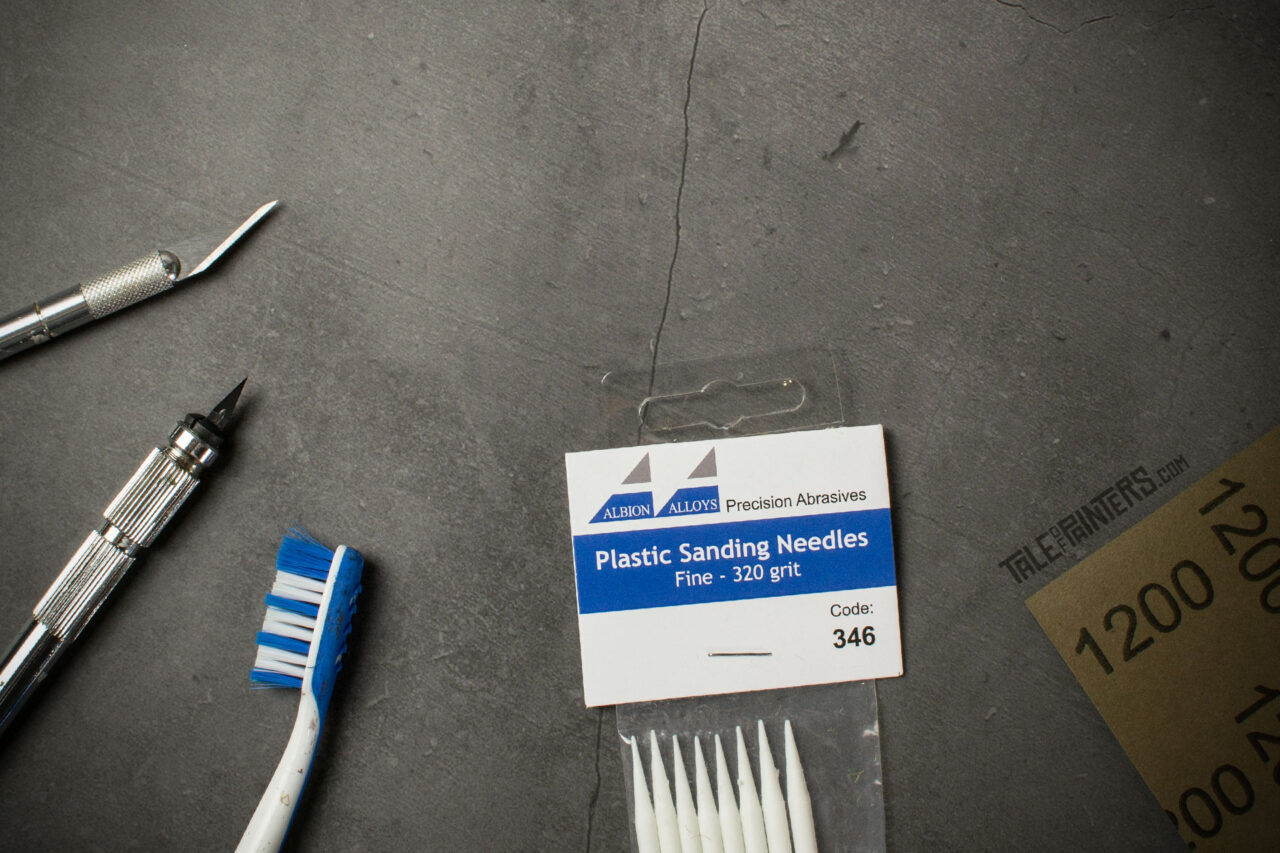![]()
![]()
Removing mould lines. The bane of our all hobby existence. Today I’ll share my favourite five tools to remove mould lines better and easier. Check out my picks after the jump, and let’s discuss your favourite tools and tips in the comment section.


1. X-Acto No.2 knife
The classic. A scalpel knife with a long, pointed blade to reach the tightest of spaces. There are various knife grips out there, for example from The Army Painter, get the one that you find the most ergonomic. For the blades, get the original ones from X-Acto as I found the quality and sharpness to be the best.
2. Micro-Mark Seam Scraper
Most people use only an X-Acto knife to scrape off mould lines, but I recommend getting a proper seam scraping tool. The Citadel one is useless, the weird shape of the blade makes it only useful on large, flat areas. Get the Seam Scraper from Micro-Mark instead. It might be difficult to find in certain regions, I ordered mine directly from the US and paid around 20 Euro with shipping, but the triangular blade has two ends and will last a good while. The Micro-Mark’s seam scraper pointed tip is sharp, can reach tight spaces, and makes scraping much more comfortable than using a flat scalpel blade. I found that if you hold an X-Acto blade at a wrong angle, it’s very easy to leave a dent accidentally, which is much harder to do with a proper scraping tool.
3. Toothbrush
When you scrape away all the excess plastic, you’ll end up with lots of tiny plastic flakes that stick all over your model. I like to use a cheap toothbrush to scrub away these tiny flakes. Just be careful with thinner, easier to break parts.
4. Sanding Needles from Albion Alloys, 320 grit
Sometimes, when scraping might not be the way to go, you might want to sand those mould lines away. You probably have a couple of modelling files, but the sanding needles from Albion Alloys are very thin and have a useful pointed tip to get into small spaces. I prefer the white version with 320 grit, a pack of 8 are about 6 pounds/8 Euro. The only downside is that the tips wear down quickly, and then you end up with a lot of plain round sanding sticks that aren’t just as useful anymore.
5. Sandpaper 1200 grit
Most hobby files are rather coarse, so whilst good for removing more pronounced mould lines quickly, the finish will be quite rough. For a super smooth finish, get some sheets of 1200 grit sandpaper, readily available in DIY stores (also pretty cheap with a single sheet about 1 pound/1,50 Euro). You can cut them to any size you find handy, for example, small stripes, wedges, larger pieces, or wrap them around a stick or tool. They are also perfect for smoothing and blending in (liquid) green stuff.
What are your favourite tools and tips to remove mould lines? Tell us in the comments and if you got any ideas or questions for future ToP tips, submit them below.








I will have to look for the Micromark tool. I use Alpha Abrasives Sanding sticks, specifically designed for modelers, much like the Tamiya ones mentioned above.
I sometimes use a SHAVIV 151-90080 Scrape-Burr scraper. Similar to the micro mark, possibly superior because of the triangular carbide blade. They are known for their deburring tools, but do make a few different scrapers that are useful for hobbyists. Having said that, the back of an x-acto blade is probably my go-to. I don't think you need to buy original x-acto blades, buy do buy blades made in USA or Japan as these are of better quality.
I searched for the seam scraper on Mirco-Mark but was unable to find it. I think they may no longer carry it. I did find the Nogo SC-8000 with the T-80 blade its a Scraper and deburring tool which I was able to find on Amazon. It works fantastic.
I remember them from when I working in a manufacturing plant the machinists would use these all the time but I never thought to apply to hobby use.
Thanks for bring this great tool back to my attention.
Similar to above, check out beauty supply stores for the sanding sponges and the padded emery boards in a variety of grits and shapes. I'd grab about two of each, you can trim them with some wire cutters. They're awesome for resin models too, but wear a mask while doing that! Also, THE best X-acto blades (#2) are from Testers Model Masters series. They are carbon hardened and a lot sharper than regular #2 blades, and they are a little longer too. The next best blades are the Xercon blades from X-acto. They have a gold tint to them. The metal is harder than the regular stainless blades, but the edge is easy to chip because of this, so be aware of this.
Good to know. I'l ltr to source some of the Testor blades once I ran through my supply of X-Acto blades 🙂
I like to keep an old Citadel "tank" or "scenery" size brush around to get plastic shavings off components that are too delicate for a toothbrush.
While I find sandpaper useful, the thing I swear by more than anything now is sanding sponge. I get a pad of this and cut it into strips as I need it, and it's perfect for taking flash, vent marks, crazing and everything else off the rounded surfaces of plastic minis. You can get cheap sanding sponge pads from a variety of suppliers, but Tamiya make them for modelling in extremely fine grit (up to 3000) and those have totally changed the way I clean up miniatures.
That sounds great, Japanese scale modelling and Gunpla companies make so many cool tools! Definitely have to check these out.